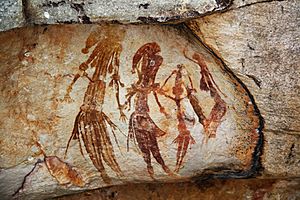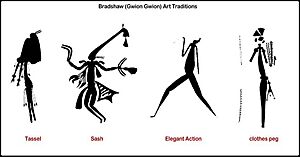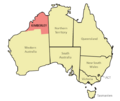Gwion Gwion rock paintings facts for kids
The Gwion Gwion rock paintings are amazing ancient artworks found in the Kimberley region of Western Australia. They are also known as Gwion figures, Kiro Kiro, or Kujon. For a long time, they were called the Bradshaw rock paintings, after Joseph Bradshaw who first recorded them in 1891.
These paintings are one of the two main types of rock art found in this part of Australia. Scientists and art experts still discuss who made them and exactly how old they are. A study from 2020 suggests that many of the human-like figures were painted about 12,000 years ago. This was figured out by looking at old wasps' nests painted over the art. The art mostly shows human figures decorated with things like bags, tassels, and fancy headdresses.
Contents
Discovering Ancient Art
The rock art in the Kimberley region was first written about by explorer George Grey in 1838. This art is now known as the Wandjina style.
In 1891, a farmer named Joseph Bradshaw was looking for land near the Roe River. He found a very different kind of rock art on a sandstone cliff. Bradshaw saw that these paintings were special and unlike the Wandjina style. He noted their fine details, colors like brown, yellow, and pale blue. He even compared them to art from Ancient Egypt.
Later, an American archaeologist named Daniel Sutherland Davidson looked at Bradshaw's notes. He wondered if Bradshaw's drawings were accurate since there were no photos. But when the original paintings were found again much later, it showed that Bradshaw was very good at drawing what he saw.
For many years, people didn't pay much attention to the Gwion Gwion art. But in the 1930s, a group of researchers from the Frobenius Institute visited the area. They noticed that local Aboriginal people didn't seem as interested in the Gwion Gwion paintings as they were in Wandjina art. However, they did recognize them as pictures of "bush spirits" or D'imi.
An Aboriginal guide told the researchers a story about how the art was made:
"Long ago Kujon a black bird, painted on the rocks. He struck his bill against the stones so that it Bleed, and with the blood he painted. He painted no animals, only human-shaped figures which probably represent spirits."
Since the 1980s, more careful work has been done to find and study more Gwion Gwion rock art sites in the Kimberley.
What Gwion Gwion Art Looks Like
An archaeologist named Grahame Walsh spent many years studying these paintings, starting in 1977. He created a huge database of 1.5 million rock art images. He also found 1,500 new rock art sites. Walsh studied how the paintings were layered on top of each other. This helped him figure out that Gwion Gwion art is very old, appearing early in the Kimberley rock art timeline.
Many of these ancient paintings still have bright colors. This is because tiny living things like bacteria and fungi have grown on them. These tiny organisms might have a special relationship with the original paint, helping the colors last.
Walsh grouped the Gwion Gwion paintings into different styles based on how they looked:
- Tassel figures: These are the oldest, most detailed, and largest figures. They have tassels hanging from their arms and waists. They also wear armbands, cone-shaped headdresses, and carry boomerangs.
- Sash figures: These look similar to Tassel figures but are drawn with stronger bodies. They have different accessories, like a three-pointed sash or bags attached to their belts.
- Elegant Action figures: These are quite different. They are almost always shown running, kneeling, or hunting with multi-barbed spears and boomerangs. It's hard to place them in the timeline because no other paintings are on top of them, and they are not painted over other styles. Also, they are the only style that hasn't been damaged.
- Clothes Peg figures: Walsh named these because they look like old wooden clothes pegs. These figures stand still and are painted in red. Parts of their bodies, like waists, arms, and feet, might be missing. This is because other colors like white and yellow have faded over time. They are shown with multi-barbed spears, spear-throwers, and woven bags. This is the newest style. The detailed body parts seen in older styles are gone, and many figures look like they are in a fight.
Gwion Gwion paintings are mostly found in rock shelters. They are usually on vertical rock surfaces, high up in cliffs. These shelters are often shallow with small overhangs and uneven floors, so they probably weren't used for living. This is different from Wandjina art, which is found in more limited places.
The paintings mainly show human shapes that seem to float or move. They look like they are running, hunting, or dancing. It's hard to tell the gender of the figures. But their arm, leg, and shoulder muscles are often well-defined. Some figures appear to be facing into the rock face, which was a new discovery. This means that what looked like "paunches" (big bellies) on some figures are actually their backsides.
The figures are decorated with belts, headdresses, bags, and tassels. Sometimes, other items like boomerangs and wands are shown. Most figures are deep purple-red, mulberry, or red to yellow-brown. Some rare ones have yellow and white colors. The paintings vary in size, from about 40 to 50 centimeters (16 to 20 inches) tall, with some as tall as 2 meters (6.5 feet).
Artistically, Gwion Gwion paintings are very advanced. The artists often drew the outline first, then filled it in. They sometimes carved lines into the rock to follow the outlines, which suggests they planned their work. Some faces are so detailed they look like real portraits. Because of the fine details, like hair strands only 1-2 millimeters thick, some experts think artists might have used feather quills to apply the paint. No mistakes or changes have been found in the paintings, but some have been repaired. About 9% of the paintings show signs of being damaged by people, like scratches or breaks.
How Old Are They?
The Gwion Gwion paintings are not the oldest art in the region. Even older art shows simple animal drawings that might be up to 40,000 years old. The Gwion Gwion art is different from this older art. It appeared after the coldest part of the last Ice Age, which was between 26,500 and 20,000 years ago.
Since the mid-1990s, scientists have used special methods to find out the age of the Gwion Gwion paintings. One method uses radiocarbon dating on mud wasp nests built over the paintings. This gives a minimum age for the art. Results show that some Gwion Gwion figures are at least 17,500 years old. Most experts agree that this art style ended around 5,000 years ago. This means the Gwion Gwion tradition might have lasted for thousands of years.
One expert, Alan Watchman, thinks the red paint on a Gwion Gwion image near the Drysdale River might be only about 3,000 years old. Other tests on paint layers suggest some Gwion Gwion art is about 3,880 years old. This would mean it was painted around the same time as, or not much older than, Wandjina art.
Around 15,000 years ago, Aboriginal people in the Kimberleys started using stone points on their spears instead of multi-barbed spears. But the Gwion Gwion paintings still show the older multi-barbed spears.
In 2008, a rock painting of what looks like a Thylacoleo (an ancient marsupial lion) was found in the Kimberley. This was only the second time a large, extinct animal was shown in Australian Indigenous art. A "clothes peg" Gwion Gwion figure was painted over the Thylacoleo. In 2009, another painting was found showing a Thylacoleo with an "elegant action" Gwion Gwion figure. Since Thylacoleo is thought to have died out 45,000–46,000 years ago, this suggests the Gwion Gwion art might be around that old too. However, some experts think these animals might have lived longer in wetter areas, suggesting the paintings could be 15,000 to 22,000 years old.
New ways of dating might help find the exact age. One idea is to use DNA sequencing from tiny living things that have replaced the paint in some artworks.
Indigenous Stories and Meanings
More research has been done to understand what Aboriginal people know about these paintings. This has led to using Aboriginal names for the art, like Gwion Gwion (from the Ngarinyin language) or giro giro (used by Aboriginal people in other areas). These names might come from Kujon, the name of a bird in a creation story.
Aboriginal people are also sharing more stories about the images with visitors. These stories often talk about spirits who created dances that are still performed today. The dancers wear similar clothes and items seen in the paintings, like headdresses, boomerangs, and string. Gwion Gwion figures are also shown in modern artworks made by Aboriginal artists in the Kimberley today.
Climate and Art Changes
When people first lived in the Kimberley region about 40,000 years ago, it had open tropical forests. After about 10,000 years of steady weather, temperatures dropped, and winds got stronger. This led to an ice age. During the coldest part of the ice age, from 25,000 to 15,000 years ago, the sea level was much lower. The coastline was about 400 kilometers (250 miles) further northwest. Australia was connected to New Guinea.
The Kimberley region became a vast grassland. Rainfall dropped by 40% to 50%. It's thought that only about 15% of Australia had trees. There might have been fewer Aboriginal people living in Australia during this very cold and dry time. As the ice age ended, the Kimberley region became a tropical monsoon climate. But then, a major dry period happened about 5,500 years ago, causing the summer monsoon rains to weaken for about 1,500 years.
The big difference between the older Gwion Gwion art and the newer Wandjina art might be linked to this severe dry period. The Gwion Gwion art style ended around this time, possibly within 500 years. The Wandjina art, which shows cloud and rain spirits, appeared about 3,800 to 4,000 years ago. This matches when the "mega-drought" ended and the rains returned, creating the climate the region has today.
Some researchers suggest that this climate change might have caused the Gwion Gwion culture to collapse. They even wonder if a new group of people replaced the Gwion Gwion artists. However, other experts disagree. They point out that there's no evidence that people stopped living in the Kimberley during this time. Also, changes in art styles have happened elsewhere in Australia without a culture collapsing. The idea of a new group of people moving in is also not supported by language studies.
See also
- Prehistoric art
- Indigenous Australian art
- List of Stone Age art
Images for kids







